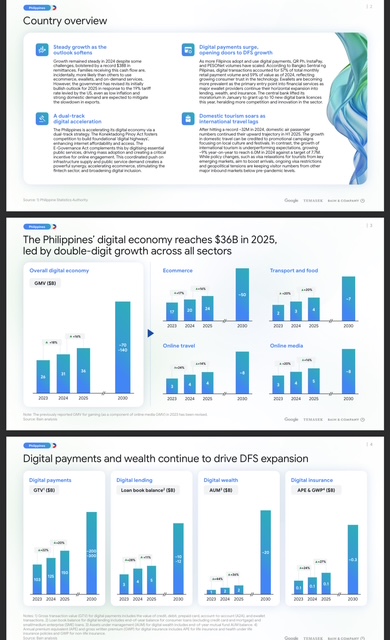The Philippine digital economy is expected to surge to USD36 billion in GMV (gross merchandise value) in 2025, up 16 percent from USD31 billion in 2024. The growth is led by strong double-digit expansions across e-commerce, transport and food delivery, online travel, and online media, according to the e-Conomy SEA 2025 report by Google, Temasek, and Bain & Company, which tracks Southeast Asia’s digital transformation.
At the launch of the report titled “From Digital Decade to AI Reality: Accelerating the Future in ASEAN” on Tuesday, Google Philippines Country Manager Prep Palacios said the Philippine momentum forms part of the broader ASEAN digital economy, which is projected to reach USD300 billion in GMV this year.
She said growth is being driven by a vibrant digital ecosystem, innovative platforms, a tech-positive regulatory environment, and increasingly “AI-curious” consumers with rising spending power.
The report showed that e-commerce has grown to USD36 billion in 2025 from USD31 billion in 2024.
“More importantly, this growth signals the robust digital transformation happening across the archipelago. This isn’t just a temporary spike—it’s a sustained, powerful shift. The digital economy is becoming truly ubiquitous,” she said.
E-commerce and digital adoption
Bennett Aquino, partner at Bain & Company, shared insights on which Philippine sectors are powering the expansion.
This strong momentum, Aquino noted, is accelerating the use of e-commerce, on-demand services, and digital payments nationwide.
The Philippines recorded the fastest growth in online media in Southeast Asia, posting 16 percent year-on-year growth, alongside Indonesia and Vietnam.
Aquino emphasized that online media’s rapid expansion is a key indicator of digital maturity and connectivity. “This 16 percent isn’t just a number—it represents billions of minutes of audience attention fundamentally shifting from traditional channels to digital screens,” he said.
He attributed this to Filipinos’ mobile-first behavior and a “social-native culture” where content consumption and communication are deeply intertwined.
Regional leader in online transport and food delivery
The online transport and food delivery sector also posted the fastest growth in ASEAN at 20 percent year-on-year, reaching USD4 billion in GMV, on par with Vietnam.
Aquino explained that companies in the sector operate in an environment where affordability is crucial, prompting them to innovate on cost-reduction initiatives—from offering dine-in vouchers to introducing more two-wheel ride options. Many food and transport providers are also lowering operational costs by optimizing logistics and streamlining operations. “In short, they are offloading the burden of fees from consumers while also lowering their own costs so they don’t have to charge more. That’s driven GMV growth over the past year,” he said.
Cash is no longer king
The backbone of the country’s digital economy, Aquino stressed, is the rapid shift to digital payments.
Gross transaction value in digital payments grew 20 percent to USD150 billion, up from USD125 billion last year. Although slightly slower than the 22 percent growth in 2024, he noted the pace remains “remarkable.”
“That is a remarkable rise in usage and traction. This behavior shift is now undisputed,” he said.
Digital payments have reached a tipping point: 57 percent of retail payment volume and 59 percent of value are now digital.
“So, the days of cash are slowly dwindling—and once that happens, it unlocks other areas of digital financial services,” Aquino said.
Digital finance expansion
Digital lending continues to grow steadily, especially for underserved communities and a rising number of SMEs seeking financing. Digital lending is expected to rise to USD5 billion, up from USD4 billion in 2024, in terms of loan book balance, while digital wealth or assets under management remain at about USD2 billion.
Aquino underscored the need to strengthen trust and safety mechanisms as digital payments become fully mainstream.
Funding landscape
Private funding in the Philippines rose significantly, driven by investments in a leading local fintech player. Funding reached USD1.1 billion in 2025 across 38 deals. In the first half of 2025 alone, private funding amounted to USD100 million across seven deals.
The Philippines currently accounts for just one percent of ASEAN-10 AI investments.
Aquino noted that while investments have stabilized in the past two years, the country needs renewed investor interest—not only in startups but also in data centers. He added that maintaining a balanced and trust-centered regulatory environment is crucial.




